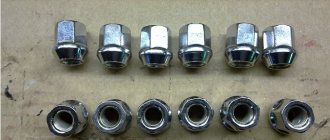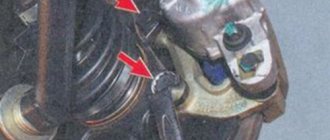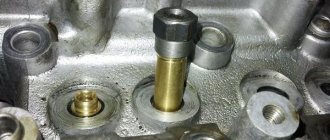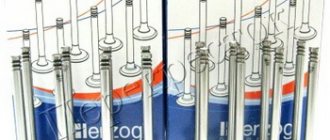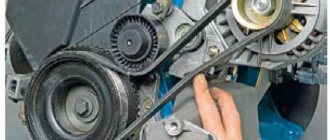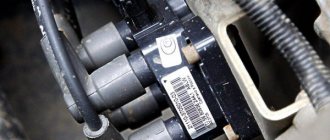If you detect a leak of engine oil or coolant at the junction of the head with the Lada Priora cylinder block, remove the head and replace its gasket. A leak can also occur due to warping of the block head due to overheating.
You will need: a torque wrench, “13”, “17”, “19” keys, “10”, “13”, “17” socket heads, “10” hex key, screwdriver.
The head gasket is a one-time use unit, so each time the head is removed, the head gasket must be replaced.
- 1. Remove the decorative engine cover (see “Removing and installing the decorative engine cover”).
- 2. Set the piston of the 1st cylinder to the TDC position of the compression stroke (see “Installing the piston of the 1st cylinder to the TDC position of the compression stroke”).
- 3. Reduce the pressure in the power system if the work is performed immediately after a trip (see “Reducing fuel pressure in the engine power system”).
- 4. Disconnect the wire from the negative terminal of the battery.
- 5. Drain the coolant (see “Replacing the coolant”).
- 6. Remove the air filter (see “Removing and installing the Lada Priora air filter”).
- 7. Disconnect the heating hoses, the small branch of the crankcase ventilation system, the canister purge, the air supply hose, the wiring harness blocks of the throttle position sensor and the idle speed controller from the throttle assembly (see “Removing and installing the throttle assembly”).
- 8. Remove the throttle assembly of the VAZ 2170 (see “Removing and installing the throttle assembly”).
- 9. Disconnect the wiring harness connectors from the Priora ignition coils. Remove the ignition coils and remove the spark plugs (see “Replacing and servicing spark plugs”).
10. Disconnect the wiring harness block from the emergency oil pressure drop sensor...
11. ...from the coolant temperature sensor of the priority engine management system...
12. ...and phase indicator.
13. Loosen the clamps and disconnect the five hoses of the Priora cooling system from the thermostat pipes.
14. Disconnect the wiring harness connector from the coolant temperature gauge sensor.
15. Using a 13mm wrench, unscrew the nut securing the tip of the “mass” wire...
16. ...and remove the wire.
17. Unscrew the nut of the fuel hose fitting and disconnect it from the fuel line tube of the VAZ 2171.
The tip of the fuel line tube is sealed with a rubber ring. Don't lose it during disassembly. Replace a severely compressed or torn sealing ring.
18. Unscrew the screw of the pressure plate of the bracket securing the fuel line to the cylinder head and remove the plate.
19. Using a 10mm wrench, unscrew the fastening bolt...
- 20. ...and disconnect the “mass” wire from the block head.
- 21. Remove the intake manifold (see “Replacing the cylinder head cover gasket for the Lada Priora”).
- 22. Remove the cylinder head cover (see “Replacing the cylinder head cover gasket”).
23. Using a 5mm hex key, unscrew the fastening bolts and remove the front protective cover of the timing belt.
24. ...and remove the lid.
25. Using a 5-point hex key, remove the bolts securing the lower front timing belt cover...
26. ...and remove the cover.
27. Using a 15mm wrench, loosen the bolt securing the tension roller VAZ 2171.
28. . and remove the timing belt.
29. While holding the camshaft pulleys of the VAZ 2170 from turning, remove the bolts securing the pulleys...
30. ...and take out the pulleys...
31. ...and remove the keys from the grooves of the shaft shanks.
To prevent the camshafts from turning when turning out the bolts securing the camshaft toothed pulleys, we recommend using the device shown in the photo.
The pulleys of the intake and exhaust camshafts have the same mounting dimensions, but a disk is attached to the pulley of the intake camshaft, which ensures the operation of the phase sensor.
32. Using a 15mm wrench, unscrew the fastening bolt and remove the tension roller.
Please note that there is a spacer ring installed under the roller.
33. Using a 15 mm wrench, unscrew the fastening bolt and remove the support roller VAZ 2170.
34. Using a 10mm wrench, unscrew the five bolts securing the rear protective cover of the timing belt.
35. . and remove the cover.
- Tightening procedure for cylinder head bolts
36. Using a 10mm hex key, unscrew the bolts securing the cylinder head to the Lada Priora cylinder block in the reverse order of tightening.
37. . and remove the cylinder head from the engine.
- Do not jam a screwdriver or other tools between the cylinder head and the cylinder block.
- It is more convenient to remove the cylinder head with an assistant, since it is quite heavy.
38. Remove the head gasket.
The cylinder head bolts become stretched with repeated use. Replace bolts whose length (excluding head height) exceeds 98 mm with new ones. Before installing the cylinder head, lubricate the bolts with a thin layer of engine oil.
39. Clean the mating surfaces of the cylinder head and cylinder block (they must be dry and clean).
40. Remove oil from the threaded holes in the block for the VAZ 2172 head bolts.
If the oil is not removed from the threaded holes for the head bolts, cracks may appear in the cylinder block when the bolts are tightened because the oil is not compressed.
41. Check the presence of two installation sleeves in the sockets of the outer holes of the cylinder block for the head bolts. If, when removing the head, the bushings remain in the head or come out of the block sockets, press them into the block until they stop.
42. Place a new VAZ 2172 head gasket on the block. Using a used gasket is not allowed. Before installing the gasket, it is necessary to remove oil from the mating surfaces of the block and its head. The gasket must be clean and dry. Oil should not come into contact with the surface of the gasket.
43. Mount the head on the block, first making sure that the crankshaft and camshafts are in the TDC position (both valves of the 1st cylinder must be closed). Tighten the cylinder head bolts in four stages:
- 1st - torque 20 N m (2 kgf m);
- 2nd - torque 69.4–85.7 N m (7.1–8.7 kgf m);
- 3rd - tighten the bolts 90°;
- 4th - finally tighten the bolts 90°.
44. Install the removed parts onto the cylinder head and connect hoses and wires to it in the reverse order of removal. Install the Lada Priora intake camshaft pulley with the disk that ensures the operation of the phase sensor to the engine. Install the VAZ 2172 exhaust camshaft pulley in the same way. Adjust the tension of the timing belt (see “Replacing the timing belt and tension roller,” page 81) and the generator drive belt (see “Checking the tension of the generator drive belt”).
Consequences of incorrect cylinder head installation
Correct tightening of the cylinder head is very important, since the performance of the motor directly depends on it. The cylinder head acts as a cylinder cover, and any violations in its fit affect the processes occurring inside the power unit.
Insufficient tightening of the head leads to a drop in compression due to loss of tightness at the junction of the cylinder head with the cylinder block, burnout of the gasket, breakthrough of working gases from the cylinders and their entry into the channels of the lubrication or cooling systems, penetration of technical fluids into the combustion chambers, which in turn is negative affects the functioning of the power unit and can cause very serious damage.
Excessive tightening also does not bring anything good; in this case, damage to the head often occurs - cracks appear, or fasteners are destroyed - bolts break, threads break, etc.
Uneven or incorrect tightening often causes warping of the head, due to which gaps appear at the junction of it with the block, which leads to the same consequences as insufficient tightening.
Part Features
The cylinder head is a structurally quite complex part. It is a massive plate in which there are channels for the circulation of fluids of the lubrication and cooling system, and technological holes - spark plugs, for injectors (in diesel engines), mounting holes.
Also on top of the cylinder head there is a so-called “bed” of the camshaft - a seat for its installation.
Despite its massiveness, the block head is a fragile part due to the voids inside, so excessive tightening force often leads to cracks in the walls and bridges.
For the manufacture of cylinder head, two types of metals are used - aluminum (the most common) and cast iron.
To secure the latter, steel bolts or studs with nuts are used. For example, the head of the UAZ 31519 block is secured with studs.
The difference in the materials used to make the head and its fasteners has one negative factor - different thermal expansion of the components when heated, especially for aluminum cylinder heads.
Uneven tightening of fasteners (nuts, studs, etc.) during thermal expansion leads to the appearance of excessive stress in the metal structure, resulting in warping of the head.
Bolt tightening conditions
When installing the cylinder head, it is important to comply with the tightening technology, which includes a number of criteria:
- Tightening order;
- An effort;
- Condition of fasteners (for example, studs with nuts);
Each engine has its own tightening order, which must be followed to ensure uniform tightening of the head to the block and to prevent the occurrence of stress on any surface areas. For example, on a VAZ 2105 it looks like this.
Force is another important factor for the correct fastening of this engine element. Attracting the plate is carried out in several approaches (their number differs on different motors), each of which is performed with its own force.
The cylinder head fasteners are tightened with quite a lot of force, which leads to them being pulled out. Therefore, on many engines, bolts cannot be reused; they must be replaced. But there are also motors for which replacement of fasteners is not necessary and their re-installation is possible.
All information regarding the cylinder head tightening technology is indicated in the technical specifications. documentation for the car, it is also often indicated on the packaging of head gaskets and fasteners.
Video “Installing and tightening the cylinder head on a Priora”
The assembly of the upper part of a 16 valve engine is presented in a video from the Expert R channel.
Do you have any questions? Specialists and readers of the AUTODVIG website will help you ask a question
Was this article helpful?
Thank you for your opinion!
The article was useful. Please share the information with your friends.
Yes (100.00%)
No
X
Please write what is wrong and leave recommendations on the article
Cancel reply
Rate this article: ( 3 votes, average: 5.00 out of 5)
Discuss the article:
General rules for performing work, methods used
There are a number of general rules that must be followed when installing the block head:
- It is important to strictly observe the tightening torque. For these purposes, a special tool is used - a torque wrench. It is not recommended to perform this operation with regular keys;
- The head bolts must be pulled smoothly, jerking is not allowed. Since the tightening force on the last approaches is significant, extending the wrench arm with a pipe can simplify the procedure and ensure smooth, uniform tightening;
- Before installing the bolts, you need to carefully inspect the condition of the threads on them. There should be no dirt or foreign particles on the coils.
- The threads of fasteners should be lubricated with engine oil before tightening. But you should not pour grease into the holes for the bolts (especially for “blind” holes), since in the future it will not allow the fasteners to be fully tightened.
Despite the fact that each engine has its own characteristics of tightening the cylinder head, the general technology of this operation is the same. In general, two methods are used to tighten fasteners:
- In several approaches, bringing the tightening force to the required value;
- Tightening the fasteners to a certain force (in one or more approaches), and then tightening the bolts twice to a certain angle.
The tightening method is selected based on the type of bolts.
The first method is used when using non-stretching bolts (these are not used now, but they can be found on old cars). But often this type of fasteners requires tightening after a certain period of engine operation in order to compensate for the shrinkage of the cylinder head gasket. But such fasteners are allowed for reuse, and more than once.
The second method of tightening the block is relevant for most modern cars. And all due to the use of tensile bolts (the so-called TTY type).
Such fasteners, due to elastic deformation, are able to compensate for thermal expansion of the head and shrinkage of the gasket, but for this they need to be put into deformation mode (in fact, just stretched a little).
To do this, it is necessary to tighten the bolts twice to a certain angle. On some cars this angle is 45 degrees, on others it is 90 degrees.
But after the elements are put into elastic deformation mode, they will no longer be able to return to their original state, and therefore their reuse is not allowed due to the high probability of destruction.
crank mechanism
The correct tightening torque for the cylinder head on a VAZ-2114
This main engine unit consists mainly of the following groups:
Each part of the group has several additional elements. For example, each piston carries a set of O-rings, a connecting pin and pin retaining clips. The crankshaft has bearings and oil seals. The most interesting thing is the structure of the connecting rods.
The principle of operation of the mechanism
VAZ engines, like other cars, are based on explosive combustion of fuel. The piston creates a certain compression of the air-gasoline mixture, a spark from the spark generator ignites it, pushing the piston down, and the crank mechanism (CPM) converts translational motion into rotational motion. This occurs due to the special shape of the crankshaft. The mounting points of the connecting rods are located so that while the connecting rods pushing the pistons rise, the connecting rods pushed by the piston are lowered. And this process takes place in shifts.
Set of connecting rods "Priors"
These parts are collapsible. The main part is made of high quality metal. Only in the upper ring, where the piston locking pin fits, is an insert made of a different metal installed. In general, the connecting rod consists of the following parts:
- connecting rod;
- liner covers;
- coupling bolts 2 pcs.;
- special washers;
- connecting rod bearing.
This is due to the fact that the liners have special grooves for the passage of engine oil. Due to the high rotation speed, this unit requires uniform and abundant lubrication. The slightest discrepancy between these grooves and the oil supply holes of the crankshaft will lead to a disruption in the flow of lubricant and, as a result, jamming of the engine.
General procedure
Although tightening the cylinder head has many nuances and features, the general technology of the operation is not complicated, it is only important to comply with the conditions.
The general algorithm of work is as follows:
- We study the documentation (tightening order and force);
- We prepare the tool;
- We inspect and wipe the surfaces of the block and head, clean the mounting holes (with a rag or compressed air);
- We lay the gasket;
- We put the block head in place (the correct placement of the gasket and head is ensured by guide bushings);
- Lubricate the threads of the fasteners;
- We install the latter in the holes and tighten them by hand;
- We specify the drawing scheme, the number of approaches and the force of each of them, as well as the time of breaks between approaches (all this is indicated in the documentation);
- We make the first approach, observing the tightening order (for convenience, you can mark the bolts according to the order with a marker). In the photo is a VAZ 2103;
- We carry out all subsequent approaches.
Some nuances
The tightening torque is one of the main factors for the normal fit of the block head. But this criterion is influenced not only by the applied force, but also by the fasteners themselves:
- General condition of the bolts – new or used;
- Presence of lubricant on the threaded part;
- Thread condition.
The type of power plant (petrol, diesel), as well as the number of valves, does not affect the cylinder head tightening technology. But this does not mean that the force and tightening procedure are identical for all motors, and before seating the head, you should definitely study the conditions for performing the operation and all its features.
Let's move on to the cylinder block
We remove the pallet. Rotating the crankshaft as it is convenient for us, unscrew two bolts on each connecting rod cap. We use a TORX E10 head for this.
We take out the pistons along with the connecting rods. To do this, use the wooden handle of a hammer to press the connecting rod from below and lightly tap it to knock it up. We remove the old liners and buy new ones of the same size according to the markings on them. Here is another stone in AvtoVAZ’s garden, the owner has never climbed into the car from the interior or into the engine, but three pistons were of group “B” and one was “C”. It turns out that at the factory they re-sharpened one cylinder a little and simply put an enlarged piston there, no words. There are no options, we take group “C”, don’t sharpen the engine because of this. We will not touch the main liners either.
We buy a new piston group that does not bend the valves, connecting rods and connecting rod bearings.
Common Mistakes
Despite the fact that automakers clearly indicate the procedure and nuances of tightening the cylinder head, many car enthusiasts make mistakes when assembling the engine. The most common of them are:
- Pouring oil into the mounting holes to lubricate the threads (the liquid is incompressible, so poured oil will not allow the head to be properly tightened);
- Over-tightening (exceeding tightening forces leads to damage to the cylinder head and the fasteners themselves);
- The use of damaged or inappropriate keys (the edges of the bolt heads may be torn off, after which it will be problematic to tighten or unscrew them normally);
- Use of unsuitable bolts as replacements (fasteners from different engines may differ in length, thread spacing, head height and diameter);
To avoid problems in the future, you should use only fasteners designed for a specific engine and fully comply with the work conditions.
Performing the operation without a torque wrench
Since the force is precisely indicated on all of these vehicles, it is impossible to do without a torque wrench when seating the cylinder head. But on some cars it is quite possible to do without it and use ordinary wrenches and an extension socket to tighten it.
Let us immediately note that performing work without special equipment. The tool is allowed only on “old” engines (Moskvich, VAZ of the first models).
A feature of tightening the cylinder head without a torque wrench is the need to “feel” the force applied. Otherwise, the general method of work is the same as using special equipment. tool:
- We tighten all the bolts by hand;
- We do the 1st approach, applying medium force (we try to pull all the bolts with the same force, smoothly and without jerking). Be sure to follow the tightening order;
- We carry out the second approach, increasing the force (in order to more accurately “feel” the force, the key with an increased shoulder should be pulled “toward” rather than pushed “away”);
- We do the third approach with high force (turn until the bolt stops).
One of the options for tightening without a torque wrench is to double tighten the fasteners after completing the 2nd approach.
Since not everyone can “feel” the applied force without the skills, it is better not to use the method without a torque wrench, because the consequences of improperly tightening the cylinder head are quite serious and can lead to very serious damage.
Therefore, before engine repairs involving removing the cylinder head, you should stock up on a special tool, especially since it will not be superfluous and there will always be a use for it.
Features of the work performed using the example of some cars
To prove the proposition that each power plant has its own characteristics of tightening the cylinder head, let’s consider the nuances of performing work on specific models.
VAZ-2112 16 valves
A number of modifications of the VAZ-2112 were equipped with two types of 16-valve power plants (factory indexes - 21120 and 21124). These two motors, despite some design features, have identical head tightening technology.
These units use 93mm long tension bolts. In this case, reuse of fasteners is allowed, but under one condition - if their length does not exceed 95 mm (if it is longer, they should be replaced). 10 bolts are used to secure the head.
Tightening is carried out in three approaches:
- The bolts are tightened according to the order with a force of 2 kg/m;
- Turning 90 degrees;
- Repeated tightening to 90 degrees.
The drawing diagram is shown below.
Between the 2nd and 3rd approaches you need to take a 20-minute break.
Since these engines use tensile bolts, additional tightening is not required during vehicle operation.
VAZ-2107
On the VAZ-2107, all installed modifications of power units are 8-valve.
The block head is attached to them with 11 bolts, 10 of which are main, and 1 is an auxiliary side bolt (installed in the side protrusion).
On this car, tightening fasteners is also performed in three approaches:
- 10 main bolts are tightened in order with a force of 3.5-4.0 kg/m;
- The same bolts reach with a torque of 11.5-12.0 kg/m;
- The auxiliary is tightened with a force of 3.5-4.0 kg/m.
Additional tightening of the cylinder head is not required when operating the VAZ-2107.
"Samara", 10th family, Priora
On models of the Samara family (2108-21099), as well as VAZ 2110-2112 with 8-valve units, tightening is already performed in 4 approaches:
- Tightening with a force of 2.0 kg/m;
- Reaching with a moment of 7.5-8.5 kg/m;
- Turn 90 degrees;
- Repeated rotation by 90 degrees.
The break between points 3 and 4 is 20 minutes.
As for the VAZ of the “tenth” family, which are equipped with 16-valve engines, their tightening technology is the same as that of the VAZ-2112 (described above).
The same applies to the Lada Priora; on 8-valve units, a method with 4 approaches is used (VAZ 2108-21099), and on 16-valve units, 3 approaches are used (VAZ 2112 with a 16-valve engine).
"Volga"
On ZMZ-406 engines installed on the Volga, according to the automaker’s technical documentation, tightening the engine block head bolts is carried out in two approaches:
- With a force of 4.0-6.0 kg/m;
- With a moment of 13.0-14.5 kg/m.
But many car owners of this car note that this technology does not allow the cylinder head to be properly tightened, so they use techniques with a large number of approaches.
A common method is the cross method, performed in 4 stages and with the following efforts:
Subsequent tightening of the bolts is not required when operating on this engine.
VAZ 2170 | Appendix: Tightening torques for threaded connections | Priora
ENGINE
| Detail | Thread | Tightening torque, N*m (kgf*m) |
| Cylinder head bolts | M12x1.25 | see section “Engine” |
| Intake pipe mounting nut | M8 | 20,83-25,73 (2,13-2,63) |
| Tension roller nut | M10x1.25 | 33,32-41,16 (3,4-4,2) |
| Camshaft bearing housing nut | M8 | 18,33-22,64 (1,87-2,3) |
| Camshaft pulley bolt | M10x1.25 | 45,82-56,6 (4,68-5,78) |
| Accessory drive housing bolt | M6 | 6,66-8,23 (0,68-0,83) |
| Cooling jacket outlet pipe mounting nut | M8 | 9,8-22,5 (1,0-2,3) |
| Main bearing cap bolt | M10x1.25 | 68,31-84,38 (6,97-8,61) |
| Oil sump bolt | M6 | 5,1-8,23 (0,52-0,84) |
| Balance shaft gear bolt | M10x1.25 | 45,82-56,6 (4,68-5,78) |
| Connecting rod cover nut | M9x1 | 43,32-53,51 (4,42-5,46) |
| Flywheel bolt | M10x1.25 | 70,81-87,47 (7,22-8,92) |
| Water pump mounting bolt | M6 | 5,10-8,23 (0,52-0,84) |
| Crankshaft pulley bolt | M12x1.25 | 87,47-108,05 (8,93-11,03) |
| Water pump inlet pipe mounting bolt | M6 | 4,2-5,1 (0,43-0,52) |
| Muffler exhaust pipe fastening nut | M8x1.25 | 19,6-24,5 (2,0-2,5) |
| Bolts for securing the front and rear suspension brackets of the power unit | M10x1.25 | 31,85-51,45 (3,25-5,25) |
| Nuts of bolts securing the suspension supports of the power unit | M10x1.25 | 28,08-45,3 (2,86-4,62) |
| Nuts for fastening the left suspension bracket of the power unit | M8 | 14,0-22,54 (1,43-2,3) |
| Bolt securing the oil receiver to the main bearing cover | M6 | 6,37-10,29 (0,65-1,05) |
| Bolt securing the oil receiver to the pump | M6 | 6,37-10,29 (0,65-1,05) |
| Oil pump mounting bolt | M6 | 8,33-10,29 (0,85-1,05) |
| Oil pump housing bolt | M6 | 6,97-8,61 (0,71-0,88) |
| Oil pump pressure reducing valve plug | M16x1.5 | 45,5-73,5 (4,6-7,5) |
| Oil filter fitting | M20x1.5 | 37,49-87,47 (3,82-8,92) |
| Carburetor mounting nuts | M8 | 6,6-15,4 (0,7-1,6) |
CLUTCH
| Detail | Thread | Tightening torque, N*m (kgf*m) |
| Bolt securing the clutch housing to the engine cylinder block | M12x1.25 | 54,2-87,6 (5,5-8,9) |
| Clutch housing cover bolt | M6 | 4,7-7,7 (0,49-0,79) |
| Nut securing the clutch housing to the gearbox housing | M8 | 15,7-25,5 (1,6-2,6) |
| Bolt securing clutch to flywheel | M8 | 19,1-30,9 (1,95-3,15) |
TRANSMISSION
| Detail | Thread | Tightening torque, N*m (kgf*m) |
| Hinge bolt on gear selector rod | M8x1 | 16,3–20,1 (1,66–2,05) |
| Gear selector mounting bolt | M6 | 5,1–8,2 (0,5–0,83) |
| Nut securing the gear shift rod clamp | M8 | 15,7–25,5 (1,6–2,6) |
| Nut of the rear end of the primary and secondary shafts | M20x1.5 | 120,8–149,2 (12,3–15,2) |
| Reversing light switch | M14x1.5 | 28,4–45,3 (2,9–4,6) |
| Bolt securing the gear fork to the rod | M8x1 | 11,7–18,6 (1,2–1,9) |
| Nut fastening the jet thrust to the power unit | M10x1.25 | 51–82,4 (5,2–8,4) |
| Speedometer drive fastening nut | M6 | 4,5–7,2 (0,45–0,73) |
| Ball joint race fastening nut | M8x1.25 | 15,9–25,8 (1,6–2,6) |
| Gear selector shaft mounting bolt | M6 | 7,8–12,3 (0,8–1,26) |
| Nut securing the rear crankcase cover | M8x1.25 | 15,7–25,5 (1,6–2,6) |
| Retainer plug | M16x1.5 | 28,4–45,3 (2,9–4,6) |
| Attaching the gear selector lever to the rod | M8x1 | 28,4–35,0 (2,9–3,6) |
| Nut securing the gearbox to the clutch housing | M8x1.25 | 15,7–25,5 (1,6–2,6) |
| Drain plug | M22x1.5 | 28,7–46,3 (2,9–4,7) |
| Clutch fork support | M8 | 15,7–25,5 (1,6–2,6) |
| Clutch release bearing guide bushing bolt | M6 | 3,8–6,2 (0,39–0,63) |
FRONT SUSPENSION
| Detail | Thread | Tightening torque, N*m (kgf*m) |
| Nut securing the upper support to the body | M8 | 19,6–24,2 (2,0–2,47) |
| Nut securing the ball joint to the suspension arm | M12x1.25 | 77,3–96 (7,9–9,8) |
| Bolt securing the ball joint to the steering knuckle | M10x1.25 | 49–61,7 (5,0–6,3) |
| Nut securing the lever to the subframe | M10x1.25 | 59,7–73,5 (6,0–7,5) |
| Nut securing the extension to the lever | M12x1.25 | 102,9–127 (10,5–13,0) |
| Telescopic stand housing nut | M48x1 | 117,5–147 (12–15) |
| Nut securing the brace to the subframe | M14x1.5 | 117,5–147 (12–15) |
| Nut securing the stabilizer to the lever | M10x1.25 | 42–52 (4,29–5,3) |
| Nut securing the stabilizer to the subframe | M8 | 12,9–15,9 (1,32–1,63) |
| Nut securing the telescopic rod rod to the upper support | M12x1.25 | 52,6–64,6 (5,35–6,6) |
| Nut securing the strut to the steering knuckle | M12x1.25 | 103–127,2 (10,5–13,0) |
| Nut securing the left side member of the subframe | M8 | 19,6–24,2 (2,0–2,47) |
| Bolt securing the subframe to the body | M12x1.25 | 83–103 (8,5–10,5) |
STEERING
| Detail | Thread | Tightening torque, N*m (kgf*m) |
| Steering gear housing clamp nut | M8 | 15,0–18,6 (1,5–1,9) |
| Steering shaft bracket mounting nut | M8 | 15,0–18,6 (1,5–1,9) |
| Bolt securing the steering shaft to the gear | M8 | 15,0–18,6 (1,5–1,9) |
| Steering wheel nut | M16x1.5 | 31,4–51 (3,2–5,2) |
| Locknut for outer steering linkage | M12x1.25 | 27,0–33,4 (2,8–3,4) |
| Bolt securing the connector to the subframe | M8x1.25 | 19,6–24,2 (2,0–2,47) |
| Steering rod ball pin nut | M12x1.25 | 27,05–33,4 (2,76–3,41) |
BRAKE SYSTEM
| Detail | Thread | Tightening torque, N*m (kgf*m) |
| Bolt securing the wheel cylinder to the brake shield | M6 | 3,31–7,72 (0,34–0,78) |
| Front wheel hub nut | M20x1.5 | 186,3–225,6 (19–23) |
| Bolt securing the shoe guide to the steering knuckle | M10x1.25 | 49–62 (5,0–6,3) |
| Bolt securing the caliper to the guide pin | M8 | 31–38 (3,16–3,87) |
| Rear brake to axle bolt | M10x1.25 | 34,3–42,6 (3,5–4,3) |
| Nut securing the master cylinder to the vacuum booster | M8 | 9,8–15,7 (1,0–1,6) |
| Nut securing the vacuum booster to the bulkhead | M8 | 9,8–15,7 (1,0–1,6) |
| Nut securing the pressure regulator to the body | M6 | 3,31–7,72 (0,34–0,79) |
| Manual brake lever lever bolt | M8 | 10,36–24,18 (1,06–2,47) |

